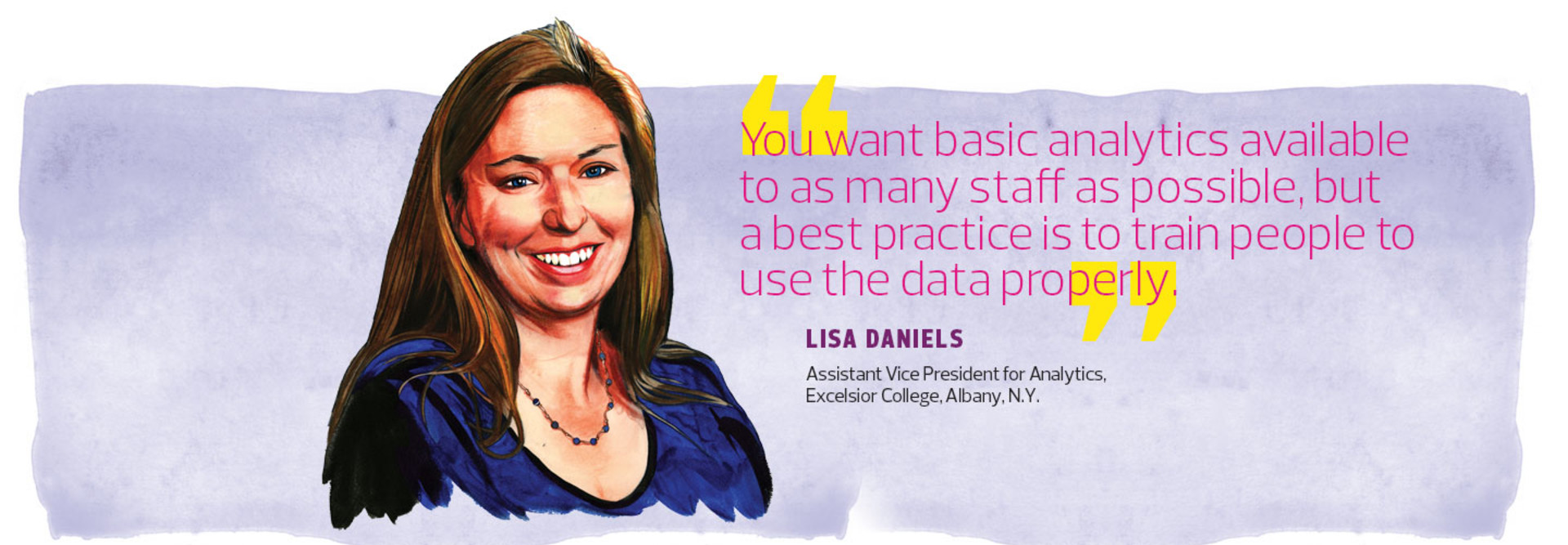The New Frontier: Lisa Daniels on the Challenges — and Opportunities — of Building an Analytics Strategy
EDTECH: What is the state of analytics today in higher education?
LISA DANIELS: Speaking broadly, in the small liberal arts colleges, you may have one person crunching data if they are lucky, and that’s probably basic analyses. And then you’ve got large public institutions that have reams of data and skilled employees with the resources and software to do some higher-level analyses, machine learning and models. What we’ve done at Excelsior College is build models that are driving business processes.
EDTECH: What is the analytics strategy at your institution?
DANIELS: The first models we’ve built are on retention and success. We recently started a Student Success Center with coaches who can discuss time management, confidence and motivation with students.
We are an online college. Most students are studying part-time. They may have families and be busy with work. We are using analytics to target our outreach and run daily models to see how at-risk a student is. We have 16 models, depending on how long they’ve been enrolled. We see how many times they are logging into their classes, that sort of thing.
We’ve also done some predictive models, predicting course enrollments to help deans plan their section levels. We’re also looking at ways to drive budget predictions. Also, most students come with transfer credit, so we’re looking for ways to predict efficiencies in our evaluation of transfer credit, so students can get through the process faster.
EDTECH: What are best practices in moving toward a data-driven decision-making model?
DANIELS: You want basic analytics available to as many staff as possible, but a best practice is to train people to use the data properly. Some of this stuff is complicated and you have to have the right people to interpret it. Train them in analytical thinking. I don’t just mean software, but thinking analytically and using data to make decisions properly.
EDTECH: What are the challenges of implementing an analytics program?
DANIELS: Some of the biggest challenges we faced are unanticipated things like data integration challenges. Another challenge is recruiting and retaining talent. We have a hard time filling positions with qualified people in analytics. There is tremendous competition, and we have a hard time paying as much because we are nonprofit.
EDTECH: From a technical perspective, what are the biggest hurdles to gathering and leveraging data from multiple systems?
DANIELS: We do have multiple systems, and we have a leader in the IT department whose focus is integrating our systems. This is somewhat of an outsider perspective, but in working with IT, one of the challenges we’ve seen is knowing what needs to be integrated and what doesn’t. It’s not efficient to integrate absolutely every piece of data from every system.
When we sit down with our business users, we develop a plan on what data needs to be integrated to build these models. We put everything in place, and once it’s launched and running, they say, “OK, we’d like to add this.” That requires going back and starting over. That is a human challenge, not a technical challenge. I’ve seen a lot of that. It causes a lot of headaches for the technical folks.
EDTECH: How are you integrating all your data? Do you have a data warehouse?
DANIELS: We are putting together a project plan and a request for proposal for our initial data warehouse. In the meantime, all our data is getting integrated into our custom student information system, which houses all the students’ academic information, transfer information, exams and courses with us.
So the student information system is the baseline, and everything gets integrated into that — the learning management system, along with Salesforce, which we use for parts of our interaction with students, and our financial aid system. That’s an important one. One of the things we take a look at with the models is if students are getting financial aid and whether it’s on time or there was a deadline missed. That could impact success.
EDTECH: How should colleges evaluate whether they need a CDO or equivalent?
DANIELS: I don’t think every college has the need or capacity. I’m thinking of the small, liberal arts college that has a fairly small population. They already have a lot of face-to-face time with students. They should look at basic statistics to inform decisions on some level, such as keeping track of their student success rate and whether certain programs are doing better than others. But they don’t necessarily need an elaborate process like I’ve described.
In terms of whether colleges should hire an analytics expert, they need to look at the top strategic challenges they are facing. Is it something that analytics could inform and drive decisions on? You have to sit on a large amount of data to have that level of program. Colleges probably have someone with an institutional research capacity doing analytics on some level, but it’s hard for me to say where the tipping point would be.
EDTECH: How does an analytics expert complement other IT or strategic roles on campus?
DANIELS: I can’t do it without the people who are incredibly technically competent at managing all those massive amounts of data. It allows me and other analysts to build models. We complement each other because the more traditional IT administrators may not have the necessary statistical background or business context to build models.
EDTECH: What benefits have you achieved with analytics so far?
DANIELS: Mostly excitement. The deans are quite thrilled that we’re rolling out course forecasting. We just started our coaching initiative, but our preliminary results are showing some impact around increased course-taking behavior. It’s too early to see retention, but I think there’s promise.
Part of The New Frontier series of interviews with top data experts in higher education.









